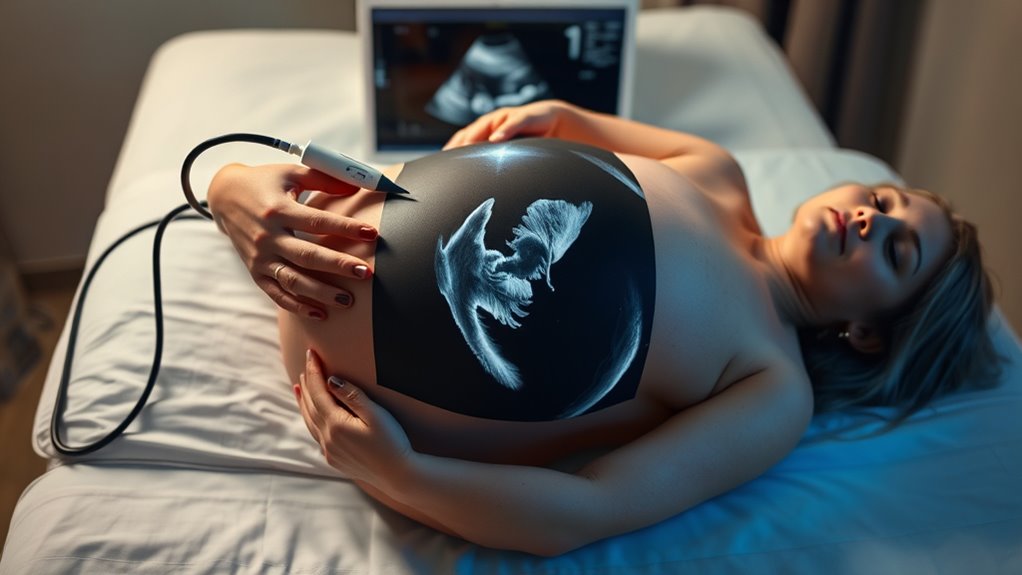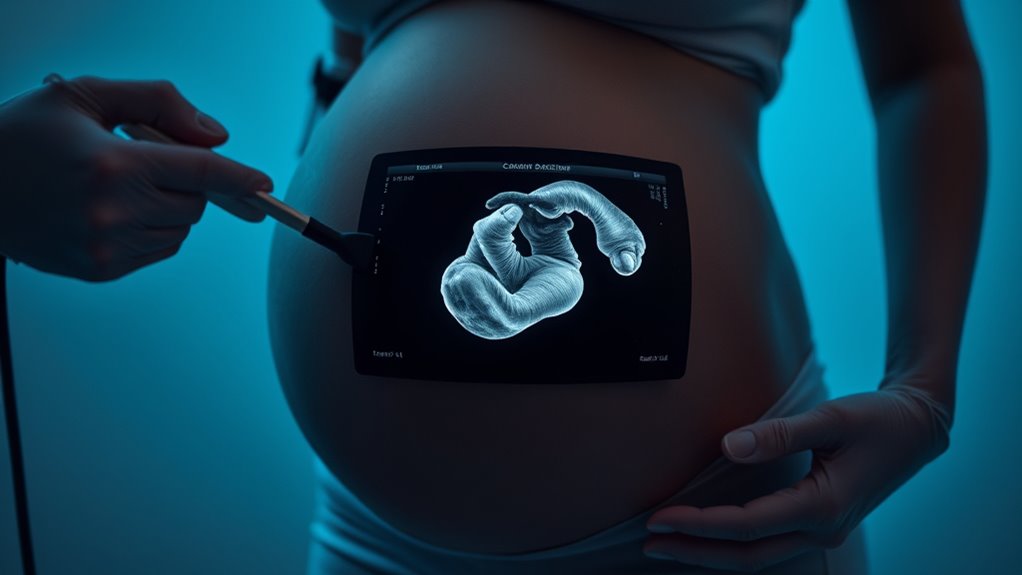During a 20-week anatomy scan, a technician uses ultrasound gel and moves the transducer across your belly to capture detailed images of your baby’s development. You’ll see real-time photos of their features, movements, and heartbeat. They measure the head, abdomen, and limbs to check growth and look for any abnormalities. The scan also assesses your placenta and amniotic fluid. If you want to learn more about what this important procedure reveals, keep exploring the details.
Key Takeaways
- A healthcare provider applies ultrasound gel and moves a transducer across the abdomen to capture real-time images of the baby.
- The scan measures fetal head, abdomen, and limb sizes to assess growth and estimate gestational age.
- Detailed images of fetal anatomy, including organs and facial features, are examined for abnormalities or anomalies.
- The procedure monitors the baby’s heartbeat, movements, and checks placental position and amniotic fluid levels.
- It provides parents with a visual connection to their baby and vital health information for prenatal care planning.

Scheduling your anatomy scan at 20 weeks is an exciting milestone in pregnancy, as it offers a detailed look at your baby’s development. At this stage, ultrasound technology allows your healthcare provider to assess fetal development thoroughly. The scan provides a window into your baby’s growth, helping identify any potential concerns early on. You’ll likely be lying comfortably on a bed, with a technician or doctor applying a gel to your belly to guarantee good contact for the ultrasound device. As the transducer moves across your abdomen, you’ll see real-time images of your baby on a screen, giving you a glimpse of their tiny features and movements.
During the scan, the technician will focus on measuring your baby’s head, abdomen, and long bones to confirm normal growth patterns. These measurements help determine if your baby is developing at a healthy rate and can also provide an estimate of gestational age. Ultrasound technology has advanced considerably, making these images clearer and more detailed than ever before. This allows for a close examination of your baby’s anatomy, including the brain, spine, heart, kidneys, and limbs. You’ll see the heart beating steadily, and if you’re lucky, you might even catch your baby yawning or stretching.
One of the primary goals of the 20-week anatomy scan is to check for any anatomical anomalies or abnormalities. The technician will evaluate the structure of your baby’s organs and limbs, ensuring they are developing properly. This is a critical step in fetal health monitoring, giving you peace of mind and allowing your healthcare provider to plan for any necessary interventions if needed. The scan also includes a check of the placenta and amniotic fluid levels, which are essential for a healthy pregnancy. If any issues are detected, your provider will discuss the next steps and possible follow-up scans or tests.
It’s normal to feel a sense of wonder during this scan. Seeing your baby’s tiny fingers, toes, and facial features for the first time can be truly heartwarming. Remember, this ultrasound isn’t just a photo op; it’s a fundamental part of prenatal care that provides valuable information about your baby’s health. While the primary focus is on fetal development, many parents find this experience emotionally moving. After the scan, your healthcare provider will review the images and measurements with you, explaining what they mean for your baby’s health and growth. This milestone not only reassures you but also deepens your connection to your developing baby.
Frequently Asked Questions
Can I See My Baby’s Gender During the Scan?
Yes, during your 20-week anatomy scan, you can usually see your baby’s gender. The ultrasound technology used in this scan provides detailed images of fetal development, including the genital area. The technician looks for specific markers to identify the sex, so if you want to know, just ask. Keep in mind, though, that sometimes fetal positioning or movement can make it tricky to determine gender accurately.
Is It Safe to Have Multiple Scans During Pregnancy?
Your concern about scan frequency is valid, but rest assured, having multiple ultrasounds is generally safe, like a tiny ripple in a vast ocean. Medical guidelines prioritize prenatal safety, and healthcare providers only recommend additional scans when necessary. These scans are non-invasive and use minimal radiation. So, unless advised otherwise by your doctor, multiple ultrasounds won’t harm you or your baby, giving you peace of mind throughout your pregnancy.
How Accurate Are the Measurements Taken at 20 Weeks?
You might wonder about measurement accuracy at 20 weeks, and it’s quite reliable for evaluating fetal growth. During the scan, your technician measures key parts like the head, abdomen, and femur. While small variations can occur, these measurements generally give a good estimate of growth progress. Keep in mind that factors like fetal position or technician experience can influence accuracy, but overall, it’s a trusted way to monitor your baby’s development at this stage.
Will the Scan Detect All Potential Birth Defects?
Imagine a scan that’s supposed to catch every possible problem—sounds incredible, right? While prenatal screening during your 20-week anatomy scan provides detailed insights into fetal development, it can’t detect every birth defect. Some issues might be too small or hidden. So, although it’s a powerful tool, it’s not foolproof. Trust your healthcare provider to interpret the results and guide you through additional testing if needed.
What Should I Do if the Scan Shows Abnormalities?
If your scan shows abnormalities, stay calm and discuss your concerns with your healthcare provider. They may recommend additional tests like genetic testing to understand fetal development better. Follow their guidance closely, ask questions, and consider consulting specialists if needed. Remember, early detection helps plan for necessary interventions or support, so stay proactive and engaged in your baby’s health journey.
Conclusion
So, now you know what really happens during your 20-week anatomy scan. With wonder and worry, you watch as your baby’s body parts come into view, revealing health and hope. It’s a moment to marvel at the miracle of life and make meaningful memories. Remember, this scan is a special step in your journey—signaling safety, showcasing surprises, and strengthening your connection. Embrace this beautiful, breathtaking beginning with confidence and curiosity.









